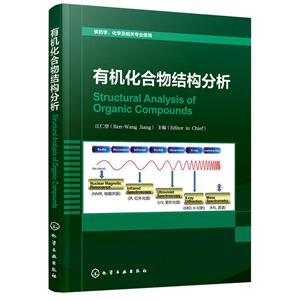预估到手价是按参与促销活动、以最优惠的购买方案计算出的价格(不含优惠券部分),仅供参考,未必等同于实际到手价。
-
>
中医基础理论
-
>
高校军事课教程
-
>
毛泽东思想和中国特色社会主义理论体系概论(2021年版)
-
>
中医内科学·全国中医药行业高等教育“十四五”规划教材
-
>
中医诊断学--新世纪第五版
-
>
中药学·全国中医药行业高等教育“十四五”规划教材
-
>
中医外科学——全国中医药行业高等教育“十四五”规划教材
有机化合物结构分析 STRUCTURAL ANALYSIS OF ORGANIC COMPOUNDS/江仁望 版权信息
- ISBN:9787122337481
- 条形码:9787122337481 ; 978-7-122-33748-1
- 装帧:一般铜版纸
- 册数:暂无
- 重量:暂无
- 所属分类:>
有机化合物结构分析 STRUCTURAL ANALYSIS OF ORGANIC COMPOUNDS/江仁望 本书特色
本教材的内容包括前言、紫外光谱、红外光谱、核磁共振、质谱、X-射线单晶衍射、综合解析六部分内容。
本教材采用理论与实例相结合的模式,安排了较多的科研实例。通过本教材的学习,学生可掌握各种波谱方法的原理、应用领域和优缺点,并掌握综合运用多种谱学手段来解析有机化合物分子结构的一般程序。
有机化合物结构分析 STRUCTURAL ANALYSIS OF ORGANIC COMPOUNDS/江仁望 内容简介
本教材的内容包括前言、紫外光谱、红外光谱、核磁共振、质谱、X-射线单晶衍射、综合解析六部分内容。 本教材采用理论与实例相结合的模式,安排了较多的科研实例。通过本教材的学习,学生可掌握各种波谱方法的原理、应用领域和优缺点,并掌握综合运用多种谱学手段来解析有机化合物分子结构的一般程序。
有机化合物结构分析 STRUCTURAL ANALYSIS OF ORGANIC COMPOUNDS/江仁望 目录
1.1Introduction of Electromagnetic Radiation1
1.1.1Electromagnetic Spectrum1
1.1.2Interaction with Electromagnetic Wave3
1.1.3Wavelength(λ),Frequency(ν)and Energy(E)5
1.2Major Spectroscopic Techniques6
1.2.1Absorption Spectrum6
1.2.2Diffraction6
1.2.3Molecular and Fragment Spectrum6
References8
Problems8
Chapter 2 Ultraviolet and Visible Spectroscopy10
2.1Introductions of Ultraviolet and Visible Spectroscopy10
2.2Principles of Ultraviolet and Visible Spectroscopy11
2.3Presentation of Ultraviolet and Visible Spectrum13
2.4Terms Describing UV Absorptions14
2.5Classification of Adsorption Bands16
2.6The Main Influencing Factors of the Maximum Wavelength17
2.6.1Conjugation Effect17
2.6.2Steric Effect19
2.6.3The Polarity of the Solvent20
2.6.4The pH of the Solution21
2.7Solvent21
2.8Relationship Between Molecular Structure and UV Spectrum22
2.8.1Saturated Hydrocarbon Compounds22
2.8.2The Simplest Unsaturated Compounds23
2.8.3The Conjugated Alkenes24
2.8.4The Conjugated Unsaturated Carbonyl Compounds25
2.8.5Aromatic Compounds27
2.9Application of UV Spectroscopy30
2.9.1Rules of Identification of Organic Compounds by UV Spectrum30
2.9.2Identification of Isomer31
References32
Problems32
Chapter 3 Infrared Spectroscopy34
3.1Introductions of Infrared Spectroscopy34
3.1.1The Representation Method of Infrared Spectrum34
3.1.2Development of IR Spectroscopy35
3.2Basic Principle of Infrared Spectrum37
3.2.1Classical Harmonic Oscillator37
3.2.2Quantum Mechanical Harmonic Oscillator39
3.2.3Degrees of Freedom41
3.2.4Modes of Atomic Vibrations42
3.2.5Certain Terms43
3.2.6Factors Affecting Absorption Intensity44
3.2.7Important Regions in IR Spectra46
3.3Characteristic Group Absorptions of Organic Compounds47
3.3.1Alkanes47
3.3.2Alkenes47
3.3.3Alkynes49
3.3.4Aromatic Hydrocarbons50
3.3.5Alcohols,Phenols,and Ethers50
3.3.6Carbonyl Groups53
3.3.7Carboxylic Amide57
3.3.8Other Nitrogen Containing Compounds58
3.4Interpretation of IR Spectra59
References60
Problems61
Chapter 4 Mass Spectrometry64
4.1Introduction64
4.1.1Principles64
4.1.2Instrumentation65
4.2Ionization Methods66
4.2.1Electron Ionization67
4.2.2Chemical Ionization68
4.2.3Electrospray Ionization69
4.2.4Atmospheric Pressure Chemical Ionization70
4.2.5Field Desorption Ionization70
4.2.6Fast Atom Bombardment Ionization71
4.2.7Matrix-Assisted Laser Desorption Ionization71
4.3Mass Analysers73
4.3.1Magnetic Sector Mass Spectrometers74
4.3.2Quadrupole Mass Spectrometers75
4.3.3Ion Trap Mass Spectrometers76
4.3.4Time-of-Flight Mass Spectrometers77
4.3.5Tandem Mass Spectrometers77
4.4Base Peak,Molecular Ions,Fragment Ions and Metastable Ions78
4.4.1Base Peak78
4.4.2Molecular Ions79
4.4.3Fragment Ions79
4.4.4Metastable Ions79
4.5Recognition of the Molecular Ion Peak80
4.6Determination of a Molecular Formula81
4.7Fragmentation 83
4.7.1Representation of Fragmentation Processes83
4.7.2Simple Cleavage83
4.8Rearrangements85
4.9Fragmentation Modes of Various Classes of Organic Compounds86
4.9.1Hydrocarbons86
4.9.2Hydroxy Compounds89
4.9.3Ethers92
4.9.4Ketones93
4.9.5Aldehydes94
4.9.6Carboxylic Acids94
4.9.7Carboxylic Esters95
4.9.8Amines96
4.9.9Amides98
References98
Problems99
Chapter 5 Nuclear Magnetic Resonance Spectroscopy101
5.1Introductions of Nuclear Magnetic Resonance101
5.2Principal of Nuclear Magnetic Resonance103
5.31H NMR Spectroscopy105
5.3.1Acquisition of 1H NMR Spectroscopy105
5.3.2Chemical Shift108
5.3.3Integration (Signal Strength)111
5.3.4Factors Influencing the Chemical Shifts112
5.3.5Coupling Constants (Spin-Spin Interactions)116
5.413C NMR Spectroscopy122
5.4.1Broadband Decoupled 13C Spectrum122
5.4.2DEPT 13C NMR Spectrum126
5.5Two-Dimensional NMR126
5.6Solid State NMR128
5.6.1Introduction of Solid State NMR128
5.6.2Application of Solid-State NMR in Pharmaceutical Polymorphism130
References132
Problems133
Chapter 6 Single Crystal X-ray Crystallography136
6.1Introductions of X-ray Crystallography136
6.2Crystal and Amorphous Solid137
6.2.1Single Crystal, Non-crystal, Twin Crystal and Powder Crystal139
6.2.2Crystal Properties140
6.2.3Symmetry in Crystals140
6.2.4Crystal Growth144
6.3Discovery and Properties of X-ray148
6.3.1Discovery of X-ray148
6.3.2X-ray Properties150
6.4Diffraction of X-ray by Crystals150
6.4.1Laue Experiment150
6.4.2Brag Equation151
6.4.3Principle of Single Crystal X-ray Diffraction153
6.4.4X-ray Diffraction Data Collection154
6.5Calculations of Electronic Density Map156
6.6The Procedures for Crystal Structure Determination158
6.7Applications of Single Crystal X-ray Crystallography in Drug Discovery and Development160
6.8Summary165
References165
Problems165
Chapter 7 Integrated Spectroscopic Analysis169
7.1Introduction169
7.2General Procedures169
7.3Examples170
7.3.1Compound A170
7.3.2Compound B173
7.3.3Compound C176
7.3.4Compound D180
References185
Problems185
Answer to Problems189
Index198
有机化合物结构分析 STRUCTURAL ANALYSIS OF ORGANIC COMPOUNDS/江仁望 作者简介
江仁望,暨南大学,教授,有机化合物光谱解析 2008- 现在,药学及中药学专业本科生,30学时 暨南大学
有机化合物光谱解析(全英) 2008- 现在,国际药学专利本科生,30学时 暨南大学
有机化合物光谱分析 2008- 现在,研究生,30学时暨南大学
药学英语2008-2014,药学、中药学、国际药学专业本科生,32学时暨南大学江仁望,暨南大学,教授,有机化合物光谱解析 2008- 现在,药学及中药学专业本科生,30学时 暨南大学
有机化合物光谱解析(全英) 2008- 现在,国际药学专利本科生,30学时 暨南大学
有机化合物光谱分析 2008- 现在,研究生,30学时
暨南大学
药学英语2008-2014,药学、中药学、国际药学专业本科生,32学时
暨南大学
江仁望教授于2008年3月加入暨南大学药学院,他依托中药及天然药物研究团队开展教学与科研工作。入职以后,他承担了药学英语及有机化合物光谱解析等本科及研究生课程的教学工作,申请并获得了国家自然科学基金、广东省科技重大专项、广州市协同创新重大专项等项目10余项,在Journal of Natural Products,
Phytochemistry, Tetrahedron, Tetrahedron Letters, Bioorganic and Medicinal
Chemistry等本学科主流的SCI期刊发表论文SCI论文100余篇,申请发明专利9项,其中7项获得授权,他是本科教学团队核心成员。
- >
推拿
推拿
¥12.2¥32.0 - >
李白与唐代文化
李白与唐代文化
¥9.5¥29.8 - >
姑妈的宝刀
姑妈的宝刀
¥11.4¥30.0 - >
诗经-先民的歌唱
诗经-先民的歌唱
¥12.3¥39.8 - >
名家带你读鲁迅:朝花夕拾
名家带你读鲁迅:朝花夕拾
¥10.5¥21.0 - >
苦雨斋序跋文-周作人自编集
苦雨斋序跋文-周作人自编集
¥6.9¥16.0 - >
莉莉和章鱼
莉莉和章鱼
¥16.0¥42.0 - >
上帝之肋:男人的真实旅程
上帝之肋:男人的真实旅程
¥19.3¥35.0
-
那时 书妆-百花小开本散文书衣
¥29.3¥38 -
北大人文课(平装)
¥14.4¥45 -
北大哲学课(平装)
¥14.4¥45 -
家居设计解剖书
¥27.3¥39 -
中医基础理论
¥40.6¥58 -
(平装)北大必修课:北大口才课
¥14.4¥45



















